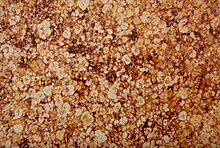Torbanite

Torbanite, also known historically as boghead coal or kerosene shale, is a variety of fine-grained black oil shale. It usually occurs as lenticular masses, often associated with deposits of Permian coals.[1][2] Torbanite is classified as lacustrine type oil shale.[3] A similar mineral, cannel coal, is classified as being a terrestrial form of oil shale, not a lacustrine type.[3]
Torbanite is named after Torbane Hill near Bathgate in West Lothian, Scotland, a major location of occurrence.[4] Torbanite found in Bathgate may have formations of bathvillite found within it.[5] Historically, two other names have been used for torbanite. Boghead coal is named after Boghead estate, also near Bathgate in Scotland. In Australia, the historical name for torbanite was kerosene shale.[6][7]
Other major deposits of torbanite are found in Pennsylvania and Illinois, US, in Mpumalanga Province in South Africa, in the Sydney Basin of New South Wales, Australia,[8] the largest deposit of which is located at Glen Davis, and in Nova Scotia, Canada.[1][4]
Organic matter (telalginite) in torbanite is derived from lipid-rich microscopic plant remains similar in appearance to the fresh-water colonial green alga Botryococcus braunii.[1][2][4] This evidence and extracellular hydrocarbons produced by the alga have led scientists to examine the alga as a source of Permian torbanites[9] and a possible producer of biofuels.[10][11] Torbanite consists of subordinate amounts of vitrinite and inertinite; however, their occurrence varies depending on deposits.[4]
A rubber-like, elastic, highly-resilient bituminous substance, known as coorongite—classified as an organic-rich sediment and named after the Coorong where it was found—has been identified as a 'peat stage' in the formation of torbanite. It provides evidence of the lacustrine and algal origin of torbanite.[6][12][13][14][11] Substances very similar to coorongite had other historical names, depending upon the location of the deposits, such as n'hangellite from Portuguese East African (now Mozambique) and marahunite from Brazil.[15]
Torbanite typically comprises 88% carbon and 11% hydrogen.[1] Paraffin oil can be distilled from some forms of torbanite, a process discovered and patented by James Young in 1851.
See also
References
- ^ a b c d Yen, Teh Fu; Chilingar, George V. (1976). Oil Shale. Amsterdam: Elsevier. pp. 4–5, 28. ISBN 978-0-444-41408-3. Retrieved 2009-07-06.
- ^ a b Lee, Sunggyu (1990). Oil Shale Technology. CRC Press. p. 20. ISBN 978-0-8493-4615-6. Retrieved 2008-05-11.
- ^ a b Hutton, A.C. (1987). "Petrographic classification of oil shales". International Journal of Coal Geology. 8 (3). Amsterdam: Elsevier: 203–231. Bibcode:1987IJCG....8..203H. doi:10.1016/0166-5162(87)90032-2. ISSN 0166-5162.
- ^ a b c d Dyni, John R. (2003). "Geology and resources of some world oil-shale deposits (Presented at Symposium on Oil Shale in Tallinn, Estonia, November 18-21, 2002)" (PDF). Oil Shale. A Scientific-Technical Journal. 20 (3). Estonian Academy Publishers: 193–252. doi:10.3176/oil.2003.3.02. ISSN 0208-189X. Retrieved 2007-06-17.
- ^ One or more of the preceding sentences incorporates text from a publication now in the public domain: Chisholm, Hugh, ed. (1911). "Bathvillite". Encyclopædia Britannica. Vol. 3 (11th ed.). Cambridge University Press. p. 521.
- ^ a b Thiessen, Reinhardt (1925). Origin of the boghead coals (Report). pp. 121–137.
- ^ "SCIENTIFIC". Australasian. 1909-11-13. p. 54. Retrieved 2023-07-21.
- ^ Brian Ayling. "Shale mining relics at Airly, Genowlan Creek and Torbane, NSW". Retrieved 2010-01-30.
- ^ Meuzelaar, Henk L. C.; Windig, Willem; Futrell, Jean H.; Harper, Alice M.; Larter, Steve R. (1986). "Pyrolysis mass spectrometry and multivariate analysis of several key world oil shale kerogens and some recent alginites". In Aczel, Thomas (ed.). Mass spectrometric characterization of shale oils: a symposium. Philadelphia: ASTM International. pp. 81–105. ISBN 978-0-8031-0467-9. Retrieved 2009-07-06.
- ^ Lee, Robert E. (1999). Phycology (3 ed.). Cambridge, [England]: Cambridge University Press. pp. 246–247. ISBN 978-0-521-63883-8.
- ^ a b "THE VALUE OF CORRONGITE". The Chronicle (Adelaide). 1925-08-22. p. 73. Retrieved 2023-07-22.
- ^ "Corrongite". Mindat.org.
- ^ "Organic-rich sediment". Mindat.org.
- ^ "COORONGITE—WHAT IS IT?". The Register (Adelaide). 1923-02-23. p. 10. Retrieved 2023-07-22.
- ^ Maxwell, James Rankin, B.Sc. (April 1967). "A Thesis entitled STUDIES IN ORGANIC GEOCHEMISTRY (submitted to the UNIVERSITY OF GLASGOW in part fulfillment of the requirements for admittance to the degree of DOCTOR OF PHILOSOPHY in the Faculty of Science" (PDF). Chemistry Department, UNIVERSITY OF GLASGOW. pp. 102, 103.
{{cite web}}: CS1 maint: multiple names: authors list (link)
